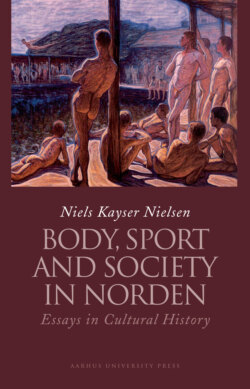Читать книгу Body, Sport and Society in Norden - Группа авторов - Страница 9
The influence of Peter Villaume
ОглавлениеChr. Ditlev Reventlow and Johann Ludvig Reventlow who took the initiative to the first systematic exercises for the common people during the 1780’ies at the estates of Pederstrup in Lolland and Brahetrolleborg respectively in southern Funen were inspired by the German philanthropic body culture (Kayser Nielsen 1993: 56 pp.). They became acquainted with it in their early years as they were students at Sorø Academy, where Johann Bernhard Basedow, who fathered the German body philanthropy in Denmark, worked as a teacher in the 1760’s. When Johann Ludvig Reventlow acquired the Brahetrolleborg estate in 1777, he began gradually to be interested in engaging Peter Villaume from Berlin to take care of teaching gymnastics to the brightest peasant children from the estate. However, he first succeeded in doing so in 1793.
This Villaume was not just anyone. Reventlow got hold of a European capacity who, with a publication of a couple of hundred pages about physical exercises, had contributed to J.H. Campe’s 16-volume education encyclopaedia Revisionsværk, written in 1785-91 (translated into Danish 1799-1806). This publication, which was primarily marked by a rationalistic and distinct systematic approach, was characteristic of Villaume’s way of thinking. It described partly the individual parts of the body, partly the individual gymnastic exercises: Each part of the body was to be trained systematically.
Secondly, special importance was attached to moral improvements, such as “the moderation of the passions”. However, it is characteristic that the way to reach this was by going through an “education of the body”. It was thought, however, that moral improvement would not matter that much if education was not linked to the body. Only in this way would knowledge reach the “power that emphasises its learning” (Villaume 1802: 218).
The third characteristic of the theory of the early rationalistic and philanthropic body culture was the thought of cultivation. It was assumed that nature had already put up a good and strong raw material that was now to be improved. Leaving it to nature’s own ability to proceed would imply surrender to a principal of chance. Instead one could meet nature and aim at an improvement of what it had made, i.e. with “the education of the body” (Villaume 1802: 193).
For that reason children should be dressed in clothes that made it possible for them to move freely, stimulating the children to play freely and not organised by adults. Another possibility was “artificial” exercises, which means constructed, systematic exercises. By this the philanthropists wished to help nature to create a “natural”, supple and moderate body. The wish for improvement of the body predisposition that is given by nature partly aimed at acknowledgement, partly at superior perspectives of physical exercises in direction of civilisation and cultivation. So the conception of nature played a role directly and indirectly.
As it is said characteristically by the vicar, P.O. Boisen, who became the principal of the college of education in Lolland with C.D. Reventlow and later a bishop: “Children are not wicked by nature, but have an ability for the good” (Boisen 1800: 5).
Villaume’s book, together with J.L. Reventlow’s Pro Memoria from 1794 about the organisation of the college of education at a rationalistic and hierarchic foundation (Reventlow 1794/1900: 106), with the main emphasis laid on order, systematic and classification, are the most distinguished sources to throw light on the real philanthropically orientated body exercises in Denmark. The fundamental ideas that are repeated in these books are a rationalistic educational and informative perspective, a distinct discipline effort as well as a desire for order and classification.
This sense of “order” was for Peter Villaume and J.L. Reventlow primarily about analytic categorisation and hierarchies, while the more down-to-earth P.O. Boisen, by the word “order” understood the opposite of disorder and “simplicity”. While the purpose of Villaume’s and Reventlow’s books was apparently to initiate gymnastics in the direction of physical activities and physical exercises, they were in fact just as much philosophical works that not only included directions of activity but also argumentation and educational reasons for these. With Boisen, however, the humanistic education thoughts went primarily in a practical direction. He was less detailed and philosophical than the others.
The sources also indicate that J.L. Reventlow had strong benefit-orientated motives with these physical exercises (if nothing else, prizes were given for diligence to those pupils who had worked particularly hard in the estate school).
From his early years in Sorø he, through Basedow, was influenced by Locke’s materialistic theory of education, i.e. that the input of the senses is the basis of intellectual recognition and, consequently, in order to eliminate the factor of chance it was important to stimulate the senses and the bodily activities, when the task was to create active and diligent peasants. Such thoughts were not unfamiliar to Villaume either. He writes about the basis of the education of the soul that the soul “gets its ideas, the reason to all its operations, only by help from the body: Through the senses” (Villaume 1802: 221). The desire to create active and “vindskibelige” (industrious) peasants was an essential part of the philosophical theories.
